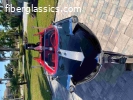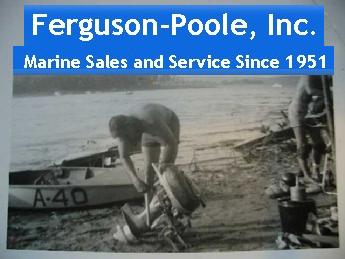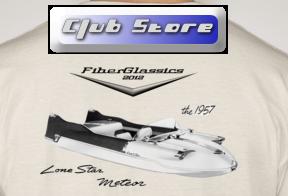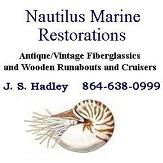Restore or Refinish
This is the question that most classic boat owners never give much thought to. That's not quite accurate. This is the question most classic boat owners don't feel equipped to answer. We all want the beautiful shiny new-looking boat, but we rarely get there because we assume it will cost us more than we're willing to spend. A new paint job seems like the only way, but a professional job is measured in thousands of dollars, not hundreds. Most of us would do it ourselves except we're not confident in our skills or have no experience with this sort of task. We ask for advice from others, but we are given conflicting accounts of the processes by everyone who seems to know more than us.
If the previous paragraph accurately describes you, then your hesitation is warranted. No single aspect of boat restoration is more littered with pitfalls, bad advice, and corner cutting than the refinishing. Additionally, no damage inflicted on a boat by the well-intentioned, but ill-equipped boat owner is as visible or costly as an improperly done cosmetic restoration or refinish.
In the next few sections, I will give you 100% of the knowledge I have spent the last twenty years acquiring. I will explain the restoration process for gelcoat, why professionals use the products they do, how they work, and the many many dangers of listening to helpful people. I will explain the boat painting process in depth, the reasons reapplying gelcoat to a boat is the restoration equivalent of wearing a hair shirt, the differences between automotive paints and marine paints and why they are not interchangeable. I will explain the the mechanical and chemical processes of polishing and why some products work and why others only appear to work. In short, I will give you all of the ammunition you need to make your boat not only look like it just rolled off the factory floor, but the knowledge to be able to do it in a way that isn't ultimately harming your boat.
I can't tell you whether or not your boat requires cosmetic restoration or total refinishing, but by the end of this tutorial, you should be equipped with the knowledge to make that decision yourself. If, by the end of this tutorial, you still have questions, I urge you to re-read it. There are very few questions that will not be answered at some point.
What I can tell you is that the general appearance of your boat's present condition is not always an accurate barometer of the what it will take to make it like new again. Surveying the cosmetic condition of your boat has less to do with looks than it has to do with a chemically and mechanically solid foundation.
Polishing Gelcoat
This is the first step in restoring your boat's finish. If the gelcoat is thick enough and mechanically sound, if the color is agreeable to you, this can also be the final step. This is also the step most fraught with danger and snake oils. The gelcoat polishing industry is rife with miracle products that are worthless, “professionals” who genuinely have no idea how badly they're damaging their customer's boats, helpful amateurs who have no idea why it's necessary to polish a boat beyond “because it looks nice”, and an almost universal misunderstanding of product usage.
Before discussing how to polish a boat, it's necessary to understand why. Obviously it looks nice. Shiny things are attractive. It's the reason we like diamonds, newly minted coins, and chrome fittings. It's the reason pack rats steal from you. It's the reason children stop in the middle of an intersection to pick up a bottle cap or other discarded bits of scrap. Shiny appeals to our aesthetic. Shiny looks like treasure. Shiny looks clean. Shiny is shiny.
Shiny is not why we polish boats. Shiny is the lucky byproduct of a safety and maintenance procedure that most of us are unaware is even necessary. A benefit definitely, but not the reason.
Oxidation and UV damage.
First, oxidation and UV damage are not the same thing and they don't have the same effect on a boat. Generally, we refer to both kinds of damage under the umbrella term “oxidation”, but it's important to know the differences between them. Technically, oxidation is a chemical reaction caused by exposure to oxygen resulting in the loss of electrons in the gelcoat. The result of oxidation is the chalking you see on the palm of your hand when you touch an unprotected boat. Sealing the gelcoat with a wax or polymer protects the boat from oxidation.
UV damage breaks down the binders in the resin used in gelcoat and leads to yellowing and an overall weakening of its mechanical structure. Polishing a gelcoat surface reflects UV light away from the boat. The more reflective the surface, the less UV penetration. The duller the finish, the more UV light will be absorbed.
While oxidation only affects the surface, UV damage penetrates the full thickness of the gelcoat and can damage the fiberglass beneath it. Oxidation increases the rate of absorption of UV light because it reduces gloss (reflectivity). Conversely, UV exposure also increases the rate of oxidation by lowering the structural density of the gelcoat.
This creates a parabolic effect where a degraded finish will continue to degrade at an ever increasing rate. In other words, a polished boat doesn't just look better than a dull boat, a polished boat will deteriorate at a slower rate than an oxidized boat.
This is why we must first polish the boat and then seal the boat.
Polished vs. Shiny
To most people, there is no difference between polished an shiny. This seemingly insignificant triviality is the reason many boats revert to their degraded state two months after being “detailed”.
Polishing is the procedure of mechanically altering the smoothness of a surface. This is done by abrading the surface with successively finer grits of sandpapers and compounds until it becomes a glass-smooth, highly-reflective surface without any further coatings. Shiny is often the result of adding a glossy coating to a surface that fills in surface imperfections and simulates polish. But a few weeks or months later, that coating will eventually evaporate or wear away, leaving only the original unpolished surface exposed and unprotected. What's even worse is that many of these glossy coatings actually increase the rate of UV absorption, in fact accelerating the rate of gelcoat deterioration.
When a new boat comes out of the factory, it's mirror-like reflection is not the result of wax or another coating. It is the result of mechanically polishing the mold prior to the boat's lay up. It is a perfectly smooth surface.
The aim of this chapter is to restore that perfectly smooth factory surface to your fifty year old classic boat and, along the way, dispel many of the myths about what polishing is or isn't.
How to Polish a Boat
Side note: I'm writing this from the perspective that your boat's gelcoat is both so severely oxidized that it requires every step in this tutorial and also from the perspective that your boat's gelcoat is still thick enough to withstand the invasive and aggressive procedures outlined here.
I strongly urge you not to start at the most aggressive step. Many boats, in fact most boats, will not need every step in this procedure.
When a boat is brought to me for gelcoat restoration, I already have some idea of what it will take to bring the boat back to a factory finish. This is because I do this for a living and I've seen literally thousands of boat undergo this procedure. Even with that experience, I still do test spots to avoid unnecessary trauma to the gelcoat.
Acting too aggressively will take years off of the life of the gelcoat. When doing test spots, start with the mildest compound in your arsenal and finish that spot through the rest of the steps. Then do another test spot starting from the next mildest compound through to completion. Continue on with the test spots until no more improvement is seen between test spots. This is your starting point.
Another factor is that levels of oxidation will vary with UV exposure. Horizontal surfaces with full exposure to the sun will be more severely oxidized than vertical surfaces exposed to only indirect sunlight. It is prudent to attack the more oxidized surfaced first and then continue to attack the entire boat with the next (milder) step in the process. The goal is to remove only as much material as is necessary to achieve the highest level of gloss.
Wet Sanding
Step one in this tutorial is wet sanding the boat. 800 grit wetordry sandpaper and a soft foam block, (see the boat painting section for more information about sanding blocks), will make quick work of the oxidation. Only use 800 grit if the boat is severely oxidized and you're sure the gelcoat is thick enough to withstand this aggressive paper. If you start at this stage, do not sand any corners or sharp edges with this coarse of a grit. Save those areas for step two.
Side note: For wet sanding, adding a few drops of liquid dish soap to the water will help lubricate the paper.
After sanding, you need to remove all of the slurry, (the sanding residue), before moving on to step two. A damp rag will get most of it. Finish wiping off the boat with a rag lightly soaked in denatured alcohol. Sanding over coarse residue will give subsequent passes with finer grit paper an uneven finish as the residue will act like ball bearings under the paper.
Cleaning the surface will also give you an opportunity to visually make sure you didn't miss any intended spots.
When the boat is fully sanded and wiped off, wet sand again, but this time with 1000 grit wetordry. You should expect to spend twice as much time sanding with 1000 grit as you did with 800 grit. This is to ensure you have removed 100% of the sanding scratches left by the coarser paper. This time, make sure to get all the corners and into the nooks and crannies.
Follow this up by cleaning the surface again. If you missed any spots or you can still see sanding scratches from coarser grit, you'll need to go over those spots again. Successive steps will not remove them entirely.
Compounding
With the wet sanding complete, the next step is compounding. This is usually where the wheels fall off for most Do-It-Yourselfers. A combination of bad advice, the wrong tools, and the wrong products cripples the process before it ever gets started. Many aspects of boat restoration are subject to variation. There are alternative procedures for nearly all tasks and projects, but not for this one. Every corner you cut here, every step you take off the path, every compromise you make is going to have a direct effect on the outcome of the project.
This is one of those rare moments in life when there is a clear right way and a clear wrong way. If you choose to vary here, do so at your own peril.
The tool needed here is called a “variable slow speed polisher” not a grinder with a buffing attachment, not an automotive detailing buffer, not a cheapo car buffer from Costco. All the major manufacturers offer a variation of this, but the industry standards are the Milwaukee #5540, the Makita #9227C, and the Dewalt #DW849.
I've owned all three of these tools at one point or another. My preference is the Milwaukee for the sole reason that it has a removable twist-lock cord. Loose connections where the cord meets the tool is a fact of life in my world. This feature is priceless to me. My second choice is the Makita because it comes with a wrap around D handle that makes polishing at weird angles much easier. I have no problems with the Dewalt, I just like the extras that come with the others.
The major factor in all of these tools is their working speed. All three have variable speeds between 0 and roughly 3000 rpm which is perfect for marine compounds and polishes. Compounds and polishes intended for gelcoat recommend machine applications between 1500 and 2500 rpm. This is considerably slower than the working speeds for automotive compounds and polishes. The reason for this is because gelcoat is a much softer material than automotive lacquers and enamels, and, because of that, it builds up much more frictional heat.
The heat generated by compounding a gelcoat surface has a direct effect on the compound itself. When you think of buffing compounds, think of them as liquid sandpaper. Essentially, it is grit floating around in a pool of solvents. As you buff the surface, the top layer is abraded by the grit. The particles of gelcoat are then emulsified in the solvents which then, by the heat generated from the spinning buffing pad, evaporates leaving the residue stuck to the pad.
When you generate too much heat, the solvents evaporate too quickly. The dead layer of gelcoat doesn't have a chance to emulsify and stays smeared onto the surface giving you a hazy, blotchy finish. To add insult to injury, the excessive heat can burn the gelcoat resulting in a brownish discoloration of the surface.
The instructions on the compound will invariably say something vague and confusing like “Start with medium pressure and lighten the pressure as the material starts to dry”. Well, hell. What does medium pressure mean? Medium for what? Medium pressure for a doorbell? Medium pressure for a heavy door? Medium pressure for foreplay? Medium pressure is useless without some frame of reference.
In my inexact experiment with my girlfriend's now very shiny bathroom scale, these are the numbers I came up with. Initial pressure, for me, was between 20 and 25 lbs of force. That was for one or two passes around a 2'x2' panel and it was mostly done to spread the compound evenly. After that, my pressure lightened up dramatically to about 15 lbs pretty consistently. that was my base working pressure. Over the course of the next 45 seconds to a minute, my pressure steadily lightened to about 10 lbs (which is approximately the weight of the tool). After that, I eased off even more until I was just grazing the surface. That lasted anywhere from 10 to 30 seconds.
I then take a clean flannel rag and hand polish any dust or residue off and inspect the panel. There should be even color and no haziness. If it is necessary to redo the panel, I will add a little more compound and lighter pressure to even out the panel.
Continue this way for the rest of the boat. When the whole boat has been compounded, rag out the whole boat again. Make sure to look at it from all angles. Swirl marks and residue can be nearly invisible from one side, but stick out like a sore thumb from another.
Side note: Swirl marks are the result of either improper buffing technique or an old compounding pad that has lost it's working qualities. Quality wool compounding and synthetic polishing pads aren't cheap. To use them long after their useful life has expired can be a great temptation, even for many professionals. However, new pads and applying even, direct pressure on the tool will virtually eliminate swirl marks.
The next step is a polishing compound. The industry standard is 3M Finesse-it II. It works the same as compound but with lighter pressure all around. It is a much finer, more liquid polish and requires less mechanical force to be effective.
For this, you should switch from the wool compounding pad to the synthetic polishing pad. The working speed is the same as the compound, just less pressure.
After each 2'x2' panel, inspect the surface and buff off any residue with a clean flannel or microfiber rag. You'll notice that I added microfiber to this step, but not to the previous step. That's because the microfiber rag will get loaded with compounding dust and residue limiting its use before it's entirely too dirty, yet adds no appreciable benefit prior to the polishing compound.
When the wet sanding, compounding and polishing stages are complete, a visual inspection of the surface will tell you if your need to use a swirl mark remover (also called a finishing glaze) with a foam pad, or if your are ready to seal the gelcoat. At this stage, the finish should be glass smooth and appear to be in new condition.
Sealing and Waxing
Congratulations! You have now successfully mechanically polished the gelcoat surface of your boat. The next step is seal the gelcoat to keep it from oxidizing and undoing all your hard work.
I use a polymerized sealer with Teflon called Starbrite Marine Polish with P-Tef. Notice the use of the word “polish” in the name. This is more about marketing than anything else. It doesn't actually polish anything. Still, the world of marine care products is highly competitive and untrue claims are the norm in packaging. I think this is an excellent sealer and I think Starbrite is doing a disservice to its customers by not marketing it that way.
Synthetic sealers don't add the depth or have the void filling characteristics of a good quality marine wax, nor do they have level of UV inhibitors found in good waxes, but they are very effective at sealing out oxygen on a long term basis. Much longer than wax alone.
Wipe on a thin coat with a clean flannel rag and buff it off by hand with a microfiber cloth after about thirty seconds. Waiting too long with this product will leave streaks.
When the whole boat has been sealed, give it about an hour to dry before adding a coat of wax. Starbrite recommends two coats 24 hours apart. I imagine this would greatly improve the durability of the finish. Unfortunately, in commercial gelcoat restoration, losing an entire day for 15 minutes of work is just not economically feasible. If you are using this tutorial as a guide and time is not a concern for you, I recommend following the manufacturer's recommendation.
Once the gelcoat has been sealed, a coat of wax will add depth and lustre to the finish as well as blend in minor surface imperfections.
There are two waxes I use regularly though each one has a downside.
The first is 3M Ultra Performance paste wax. It is applied like traditional waxes. Using a clean flannel rag or a wax applicator, apply the wax using a small circular pattern. Allow it to haze up completely and either use a polisher with a synthetic polishing pad or a microfiber cloth by hand to buff it out. I prefer to use the cloth by hand because I have more control getting it to the right gloss without removing too much wax. The downside is the amount of buffing to get it to that point. It will look 80% OK after about 5 seconds of buffing, but that last 20% takes minutes on a 2'x2' panel. Sometimes this just isn't an option. On large boats that can't be done by hand in a reasonable time, I initially buff with the polisher until it's close, but finish up by hand. This method does remove more wax from the surface than hand buffing, but it's considerably faster.
The other wax I prefer is Collinite #885 Fleetwax. While the first wax mentioned is applied traditionally, the Collinite Fleetwax utilizes a wet-rag method. The instructions are printed on the can and they are not just a suggestion.
The wax is applied using a damp rag that must be constantly turned over for each trip back to the can. The wax is then buffed out immediately while the wax is still wet. This is known as the wet-rag method and it's a trick used on hot days in direct sunlight for applying normal paste waxes. The moisture of the damp rag is used as a thinner to prevent the wax from solidifying too quickly. Wax that cures too rapidly makes buffing very difficult to do evenly. It is a testament the strength of Collinite's finish that it must be wet-ragged on, even in average climates.
There are two downsides to Collinite's Fleetwax. The first is that it must be done by hand. Mechanical buffing is not an option with this wax unless you have a second person to either apply the wax as you buff right next to them, or vice versa.. The second downside is actually a byproduct of its quality; in some situations, it's too effective.
I used to polish and wax a 60' torpedo-shaped Sea Ray. One year I used Collinite. Two weeks later, I got a call from the company that provided the boat with a weekly wash service asking me not to use Collinite on the slick surfaces where the boat washers had to walk. It seems they were unable to wash the boat standing up without fear of sliding off the brow and into the water.
That may sound like a good thing, but that kind of finish can be deadly at sea. If you have large areas that need to be waxed and people need to walk on that area from time to time, I would seriously consider not using Collinite Fleetwax.
I didn't mention this earlier and maybe I should have, but don't wax the non-skid areas of your boat. All wax is slick and safety should always be of paramount importance on the water. For non-skid areas, there are a number of sealers designed specifically for this purpose. They seal very well, have UV inhibitors, and designed for people to walk on. (Before you think, why not just do the whole boat with that? They are hazy)
Don't do this
Never use a solvent to shine up your boat. Penetrol, WD-40, or other similar products are solvents. They are designed to emulsify solids. The reason they look good, is because they are oils. You can get the same effect by going to the kitchen and pouring a bottle of Wesson oil on your boat. I guarantee you it will be shiny. That doesn't mean it has any merit. Solvents like WD-40 and Penetrol are very slow evaporating solvents, that's why they're used as a brushing thinner and a temporary lubricant, but they will evaporate, and when they do, they will take emulsified particles of gelcoat with them. The result will be a surface in far worse condition than before. But wait! There's more! Solvents actually increase the level of UV absorption and the rate of oxidation by leeching out residual waxes and sealants from the porous gelcoat as they evaporate.
Never use one-step cleaner waxes for the same reasons mentioned above, though to a much lesser degree. One step cleaner waxes use solvents to “clean” the surface and oils to provide a false gloss to the surface. When the wax in the product wears off, (which it will soon), the result will be similar to the scenario with Penetrol.
Never use caranauba waxes, (or use them every two weeks for ever). For most people, buffing and waxing a boat is an annual affair. If the boat is lucky, it might get a second coat at the end of the season, but most will never get that much. Caranauba is the only word people know when it comes to wax. Therefore, they assume it's because it's the best. This is evidenced by the marketing on some labels, “100% Pure Caranauba!” It may exclaim on the packaging, but that just reminds me of an old commercial from the seventies where a salesman lovingly pats the top of the television set and proudly declares, “Genuine plastic”.
Caranuaba is a lovely wax that comes from the leaf of the caranauba plant. It adds lustre and depth to surfaces and then promptly wears off after a few weeks. The market for caranauba is the automotive market. Because people get their cars washed and waxed many times in a year, its longevity is not as much at issue in that market. It's not a matter of how it looks, it's how long it will last. No wax is magic. None are going to look as good or be as thick a year later, but marine grade polymerized waxes will outlast all others and still provide some level of protection throughout the year.
Courtesy of Glass Clown Boats












